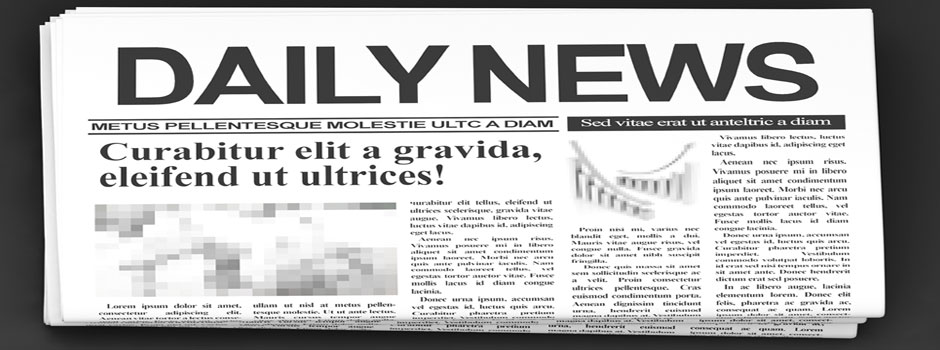I am a journalist. I’m possessive; don’t mess with my work! I don’t like people rewriting me work however they like. I take full ownership of my copy and I stand by my claim. I take all the necessary measures to make sure my work does not need any changes, either in form or content, when it is proofread. That goes for the headline as much as for the copy. When I submit a text for proofreading, it must be print-ready, i.e. with a headline, maybe a kicker or a subheader, and, no matter what, one or more crossheads. It makes me feel safer and makes the proofreader’s or editorial office’s job easier.
A RANGE OF GENRES TO CHOOSE FROM.
For each genre of article, there is a corresponding headline style. But each type of headline has its own internal differences. Serious or lighthearted, long or short, big or small, simple or complex, informative or provocative, etc. What’s more, your headline also needs to adhere to your newspaper’s architecture, its layout, its rules, which vary from paper to paper. Some editorial charters call for multi-deck headlines, while others shun a kicker-headline-subhead-lead paragraph structure.
The one-liner. The best headline is always the simplest. Why say in two lines what you can say in one? Why take up space with additional details when one headline sums it up? The best headline is one informative sentence, one that answers two basic questions in one short sentence: “who” and “what”?:
“Mark Pesos moves to Moray.”
***
In the provocative single-sentence genre, the best headline is one that expresses the author’s emotion in as few words as possible:
“Moray says no to banker!”
***
Accessory headlines. Once I have my main headline, it’s easy to add additional elements. If I add a kicker and subhead, I end up with a triple-sentence headline. If I just add a subhead, I end up with a double-sentence headline.
In the informative genre, the kicker should answer the questions “where? and when?”; the subhead should answer the “how?”, “why?”, “with who?” and “with what?”. This gives the overall headline an aesthetic symmetry as the subhead and the kicker frame the mean headline like a painting. A triple-sentence headline looks like this:
Kicker: “Arrival in the island’s port this morning with security detail”.
Headline: “Mark Pesos moves to Moray.”
Subheader: “The well-known banker wants to set up his new high-security residence on a protected nature site”
***
In the provocative triple-sentence genre, the kicker should still be informative but should support the main headline; the main headline expresses an editorial judgement; the subheader serves as a crescendo, building on the main headline:
Kicker: “Mark Pesos wants to move Dosh head office to the island”.
Headline: “Moray says no to banker!”
Subheader: “Disgruntled islanders form an association and plan demonstrations”.
***
There is also a mixed form: the two-sentence headline. This consists of a single-sentence main headline with a subheader that combines the information given in the kicker and subheader of the three-sentence genre:
Headline: “Mark Pesos moves to Moray.”
Subheader: “The banker wants to build his residence in an area of the island that he visited this morning accompanied by his security detail”.
This mixed form is generally followed by a lead paragraph introducing the story. This inverse pyramid formula offers the reader three reading levels before they get to the story itself.
***
All journalistic headlines are formed by adapting or combining these three models. In general, the layout dictates the template used for the headline.
Single-sentence headlines are particularly good for comment pieces: editorials, opinion pieces, columns. The best formula here is one word per column: 1 column: “Resistance!” 2 columns: “No pasaran! 3 columns: “Vade retro Pesos!”
Two-sentence headlines are good for reports:
“Life in our small corner of paradise has become a nightmare”.
The exclusive report from our special correspondent speak to islanders who have resolved to prevent Mark Pesos from moving there.
***
Two-sentence headlines are also good for investigations:
“Thomas Riel funding his buildings with dirty money”.
“The mayor of Moray receives financial support from discredited businessman”.
***
Two-sentence headlines are also good for interviews:
An interview with Marine Waterman, the chair of the association of disgruntled islanders.
“Our island is not a vault!”
***
As for the crossheads, these are not only visual cues that enliven stories and make them less compact and easier to read. They also give rhythm to your text, bringing the reader back to the story. They must be carefully thought up: they must not be redundant, repeating content used in the headline, kicker or subheader. If you choose well, they highlight useful information: “Maximum security”, “3000 m2”, “200 employees”,…
RESIST THE URGE TO USE SENSATIONALIST HEADLINES.
Competition sometimes leads the written press to choose sensationalist headlines to provoke a reaction, using puns, wordplay, or plays on the titles of books, films, TV shows, etc. Giving in to this temptation can sometimes lead to comical results. But is this a good idea for a serious newspaper? By opting for these easy options, you lower your journalistic writing to the level of juvenile amusement. This should be left to satirical publications.

